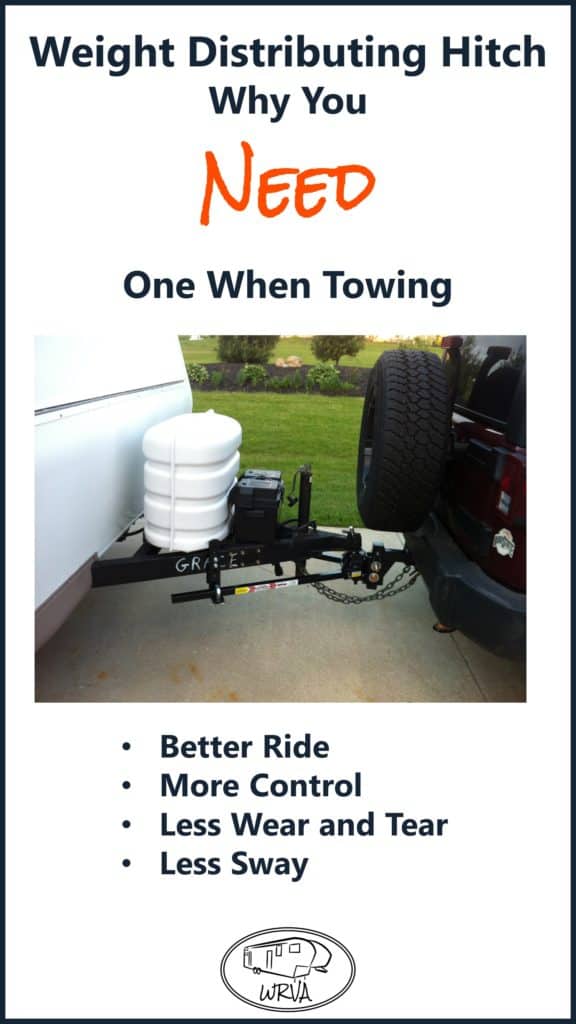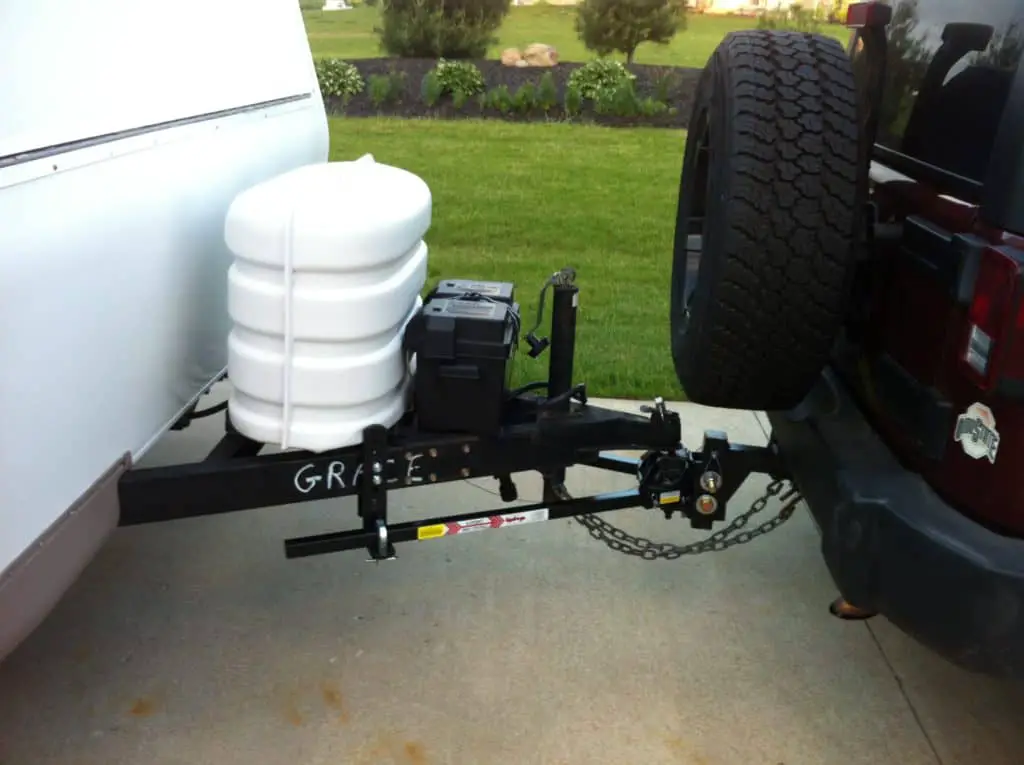If you are towing a trailer which, when fully loaded, weighs more than 5,000 pounds or more than 50% of your tow vehicle’s weight and you aren’t using a Weight Distributing Hitch (WHD), then you probably already have experienced the primary reason why you need one.
When you connect the trailer to the tow hitch does the rear of the vehicle (which for simplicity we are going to consider to be a truck) and the front of the trailer both sag downward? If so, you are seriously compromising the truck’s handling capability, which accelerates wear and tear on the tires and suspension, and – more importantly – isn’t safe Weight Distributing Hitches correct this problem.
My favorite is the Equal-i-zer hitch, but we will get to more about that later.
Level is Good
Ideally, the height of the truck and that of the trailer should be equal, so this sagging causes too much weight to be bearing on the tow vehicle’s rear axle and not enough on the front. That means the truck’s front tires aren’t as fully in contact with the road as they should be, making steering, turning and braking much harder.
Sway is Bad
If you have either been passed by an 18-wheeler or have driven in unusually windy conditions, you probably noticed your trailer started to sway. In the most severe conditions, this can extremely dangerous. The three WHD systems reviewed below all combine weight distribution and sway control features, providing you with a much smoother, calmer and safer driving experience.
Trailer Weight Ratings
There are two trailer-specific and weight-related terms with which you must be familiar when considering a WHD: Gross Trailer Weight and Tongue Weight. You want to be sure the WHD you are considering is rated just above both ratings.
Gross Trailer Weight (GTW)
This is the total weight of the trailer including all its contents, propane tanks, bikes and rack on the back, spare tires, etc.
Tongue Weight (TW)
This is the combination of the part of the GTW (usually 10-15%) which is closest to the front of the trailer and the weight of all the gear loaded in the bed of the truck behind the rear axle which bears on the hitch and causes the truck and trailer to sag.
Truck Weight Ratings
- All truck manufacturers provide a Gross Vehicle Weight Rating (GVWR) and Gross Combined Weight Rating (GCWR), the latter being the maximum total weight of the truck and fully loaded trailer. You should consult your owner’s manual, so you know the GCWR of your truck. Most truck manufacturers will also require – or, highly recommend – you use a WHD when the gross trailer weigh is equal to or greater than the GVWR.
- In the case of a 2017 Chevrolet Silverado 2500HD with a 6.0L V8 with 6-speed transmission, the GVWR is 9,500 lbs. and the GCWR is 23,800 lbs. That means the maximum weight of the heaviest fully-loaded trailer you can tow is 14,300 lbs. and since the trailer’s weight is more than 50% of the GVWR, you must use a WDH.
- It should be noted that all vehicle (truck, SUV and passenger car) manufacturers do not recommend using a WDH when towing. Also, some surge and/or hydraulic systems are not compatible with WHDs, so in both cases check your vehicle’s operation manual to be sure.
How They Work
Using a WDH won’t increase the amount of weight your truck can tow, but it will get you much closer to the maximum rating than without it. It does this by evenly distributing the GCW to all the axles of both the truck and trailer, eliminating the noticeable sag and instead allowing the truck and trailer to both be level and handle more as one unit. The parts of a WHD include the following:
Adjustable Hitch Bar or Shank
This is an L-shaped bracket to which the Ball Mount Assembly is connected. The horizontal leg of which is inserted and locked into the hitch receiver and the vertical leg, which usually has 4 holes spaced 1 inch apart can be turned in either an upward (rise) or downward (drop) position.
Ball Mount Assembly
This is what the Hitch Ball and Spring Bars are attached to.
Hitch Ball
This is what the trailer hitch coupler is attached to. Be sure you have the correct diameter ball to match the coupler.
Spring Bars
These come in different configurations, but all connect the Ball Mount Assembly to the trailer A-frame. When fully connected, they counter the downward load of the trailer tongue and distribute the GCW to all axles of the combined rig.
Brackets or Chains
These connect the free ends of the Spring bars to the A-frame.
WDH System Comparison
Below is a comparison of 3 of the best Weight Distribution Hitches. If you are in the market for a new hitch these are great options.
| Brand Name |
Equal-i-zer 4-Point Sway Control Hitch |
Reese Strait-Line 1,200 lb Trunnion Style Weight Distribution Kit |
Anderson No-Sway Weight Distribution Hitch |
|---|---|---|---|
| Model # |
90-00-100 |
66704 |
3350 |
| Gross Trailer Weight (lbs) |
10,000 |
12,000 |
14,000 |
| Max. Tongue Weight (lbs) | 1,000 |
1,200 |
1,400 |
| Detach When Backing |
No |
No |
No |
| Ball Included |
No |
No |
Yes |
| Spring Bar Style |
Trunnion |
Trunnion | Chain |
| Warranty |
Limited Lifetime |
Limited Lifetime |
Limited 1- Year |
| Shipping Weight (lbs) |
103 |
72 |
60 |
| Where to Buy | Check Price on Amazon | Check Price on Amazon | Check Price on Amazon |
System Details
The configuration of the Equal-i-zer and Reese systems are similar, while Anderson does it a little differently.
While I love my Andersen Ultimate 5th Wheel Hitch, the Equal-i-zer is my favorite weight distributing hitch. I used the Equal-i-zer hitch for a couple years with my first camper. That was a 19 foot Shamrock hybrid camper. It was used with 2 different tow vehicles a 4-door Jeep wrangler and a Ram 1500. It performed great with both vehicles, but really improved the ride with the Jeep.
Each of these are available in different weight ratings. Use the links for each product below to find the other options.
Equal-i-zer

- Uses square trunnion style bars and rigid brackets which bolt directly to the A-frame and into which fit the square trunnion bars which provide linear sway control along with rotational control at the Ball Mount.
- The ball is not included and must be purchased separately.
Click Here to see the Equalizer Hitch on Amazon
Pros
- Very easy to follow instructions
- Can connect at any angle
Cons
- Ball not included
- Metal-on-metal friction control can be very noisy
Reese
- Also uses trunnion style bars with a unique curved end along with snap-up brackets, chains and separate piston-like cams (installation of which requires drilling the trailer A-frame) which provide mostly linear friction.
- The ball is not included and must be purchased separately.
Click Here to see the Reese Strait-Line on Amazon
Pros
- Cams very quiet
- Easy to backup
Cons
- Installing a little more complicated
- No ball or shank included
Anderson

- This system uses chains and not bars along with a proprietary shock dampening system to control sway.
- A proprietary Ball Mount Assembly which includes an integral ball along with a unique triangle plate and doesn’t use sway bars at all, but rather chains.
- The manufacturer claims the system also limits bouncing when you are driving on rough paved surfaces or off-road.
Click Here to see the Andersen Hitch on Amazon
Pros
- Ball included
- Controls bounce as well as lateral sway
Cons
- Adjusting compression bushings can sometimes be tricky
- Extension kit may be required
Wrap-Up
If you aren’t used to towing a trailer it can be challenging ,especially backing up (check this article out for some great tips). So, don’t let a poor hitch setup make towing even harder and more dangerous.
Here’s a recap of the reasons why you should be using a Weight Distributing Hitch

- Prevents extra wear and tear on your truck
- Allows you to tow the maximum weight trailer allowed by your truck’s manufacturer
- Significantly improves steering, turning and breaking
- Provides a much more comfortable ride travelling to and from the campsite.
- IT’S MUCH SAFER
Thanks for reading. If you found this article helpful please share it and help others find it too.


Have you considered weight distribution hitch storage? HITCHPORT Hitch and Spring Bar Storage Mounts are the solution. hitchport.com
I haven’t, but it looks like an interesting solution.